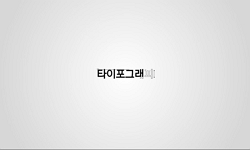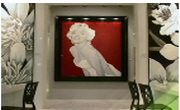Font is a medium that allows the power of the message to be expressed beyond the means of the words. For example, if text of exactly the same content is presented in three different font types, the reader receives a different impression depending on t...
http://chineseinput.net/에서 pinyin(병음)방식으로 중국어를 변환할 수 있습니다.
변환된 중국어를 복사하여 사용하시면 됩니다.
- 中文 을 입력하시려면 zhongwen을 입력하시고 space를누르시면됩니다.
- 北京 을 입력하시려면 beijing을 입력하시고 space를 누르시면 됩니다.

섞어짜기를 위한 돋움체 기반 흘림체 디자인 방법론 = A Methodology of Cursive Font Design for Mixed Typesetting based on the Form and Structure of Dotum Font
한글로보기https://www.riss.kr/link?id=A106358240
- 저자
- 발행기관
- 학술지명
- 권호사항
-
발행연도
2019
-
작성언어
Korean
-
주제어
글자체 ; 타이포그래피 ; 돋움체 ; 흘림체 ; 돋움 흘림체 ; 섞어 짜기 ; font ; typography ; san serif ; cursive ; italic ; san serif italic ; mixed typesetting
-
등재정보
KCI등재
-
자료형태
학술저널
- 발행기관 URL
-
수록면
501-514(14쪽)
-
KCI 피인용횟수
0
- DOI식별코드
- 제공처
- 소장기관
-
0
상세조회 -
0
다운로드
부가정보
다국어 초록 (Multilingual Abstract)
italic font is generally used to express emphasis, for the titles of created works (books, movies, art, ships, etc), to write words from other languages, etc. However, in Hangul these features of language are expressed through the use of punctuation marks. Mixed typesetting therefore needs to develop a new Hangul font similar to the italic font. Reflecting a recognition of this issue, there is now an attempt to release a Hangul cursive design based on Batang font, a serif font style based on the Latin alphabet However, there is currently no Hangul cursive design based on the Dotum font (a font similar to the sans serif font style of the Latin alphabet). The Batang cursive font differs to Dotum cursive font. Therefore, there is a need to develop a Dotum cursive font design. For mixed typesetting, consideration must be given to matching Dotum regular and cursive fonts. This necessitates a design methodology concerning the font structures of Dotum regular and Dotum cursive font. From the 1900-2000s, four representative Dotum regular fonts have been set based on analysis standards. These analysis standards consist of: 1)basic font elements; 2)detailed features; 3)height; and 4)width. A basic methodology for designing a Dotum cursive font consists of an exploration of adjusted structures following the overlap of regular and cursive fonts. Next to develop the cursive connecting stroke, a detailed adjustment of horizontal typesetting is conducted based on the Dotum regular font. Based on the results, the basic design should consist of 1)structure, form; 2)angle, connecting stroke; and 3)adjustment of horizontal typesetting. The author has chosen “Dotum cursive font” as the font name, based on the Dotum font. This thesis presents a basic methodology used in the design of the Hangul Dotum cursive font. Design of the Hangul Dotum cursive font is ongoing.
Font is a medium that allows the power of the message to be expressed beyond the means of the words. For example, if text of exactly the same content is presented in three different font types, the reader receives a different impression depending on the form of the font. Font design continues to develop for the important purpose of expressing text. However, Hangul lacks a range of mixed typesetting expression fonts, such as the italic font used in the Latin alphabet.
italic font is generally used to express emphasis, for the titles of created works (books, movies, art, ships, etc), to write words from other languages, etc. However, in Hangul these features of language are expressed through the use of punctuation marks. Mixed typesetting therefore needs to develop a new Hangul font similar to the italic font. Reflecting a recognition of this issue, there is now an attempt to release a Hangul cursive design based on Batang font, a serif font style based on the Latin alphabet However, there is currently no Hangul cursive design based on the Dotum font (a font similar to the sans serif font style of the Latin alphabet). The Batang cursive font differs to Dotum cursive font. Therefore, there is a need to develop a Dotum cursive font design. For mixed typesetting, consideration must be given to matching Dotum regular and cursive fonts. This necessitates a design methodology concerning the font structures of Dotum regular and Dotum cursive font. From the 1900-2000s, four representative Dotum regular fonts have been set based on analysis standards. These analysis standards consist of: 1)basic font elements; 2)detailed features; 3)height; and 4)width. A basic methodology for designing a Dotum cursive font consists of an exploration of adjusted structures following the overlap of regular and cursive fonts. Next to develop the cursive connecting stroke, a detailed adjustment of horizontal typesetting is conducted based on the Dotum regular font. Based on the results, the basic design should consist of 1)structure, form; 2)angle, connecting stroke; and 3)adjustment of horizontal typesetting. The author has chosen “Dotum cursive font” as the font name, based on the Dotum font. This thesis presents a basic methodology used in the design of the Hangul Dotum cursive font. Design of the Hangul Dotum cursive font is ongoing.
국문 초록 (Abstract)
글자는 단순히 내용을 표현하는 도구를 넘어 그 형태가 주는 메시지의 힘이 분명하게 존재하는 매체다. 가령 같은 내용의 본문을 다른 세 가지 글자체로 사용할 경우 글자체 형태에 따라 다...
글자는 단순히 내용을 표현하는 도구를 넘어 그 형태가 주는 메시지의 힘이 분명하게 존재하는 매체다. 가령 같은 내용의 본문을 다른 세 가지 글자체로 사용할 경우 글자체 형태에 따라 다른 인상을 받는다. 글자체 형태는내용을 표현하는데 중요한 이유로 계속해서 발전하고 있다. 하지만 아쉽게도 한글은 라틴알파벳 ‘이탤릭’과 같이 정체와 함께 섞어짜기에 적합한 글자체가 부족하다. 라틴알파벳에서 이탤릭은 일반적으로 이름, 인용, 대화등을 위해 활용하는데, 한글은 대부분 문장부호로 대체한다. 섞어짜기를 위해 이탤릭체와 같이 새로운 한글 글자체 개발이 필요하다. 이런 문제의식을 반영하듯, 최근 흘림체가 출시되는 시도가 있지만 대부분 바탕체 형태에 의존하여 만드는 아쉬움이 있다. 바탕체뿐 아니라 돋움체는 사용 빈도가 높고, 제목과 본문에서 두루 활용한다. 돋움체의 형태와 어울리는 흘림체 디자인은 아직 없는 이유로 그 개발의 필요와 가치가 충분하다. 다만, 돋움 정자체와 섞어짜기 할 수 있는 특별한 흘림체 디자인 방법이 필요하다. 이에 1900년~2000년대 디지털 환경에서 제목과 본문에 두루 활용된 돋움체 네 가지와 흘림체 네 가지의 1)글꼴 기본요소 2)세부특징 3)높이 4) 넓이를 분석했고, 디자인을 위한 글자체 기초 방법으로 먼저 돋움체와 흘림체를 서로 겹쳐 골격을 만들었다. 이어 흘림체 특징인 기울기와 이음선을 반영했고, 정자체를 기준으로 가로짜기에 맞게 조정했다. 즉, 1)골격, 형태2)기울기, 이음선 3)가로짜기에 맞게 조정하는 순으로 돋움 흘림체 기초 방법을 정했다. 돋움체를 기반으로 하는 흘림체를 ‘돋움 흘림체’로 연구자가 연구에 명명하기 위해 정한 이름임을 밝힌다. 이 연구는 돋움 흘림체 디자인을 위한 기초 방법론을 세우는 것이 목적이며, 나아가 돋움 흘림체 디자인을 이어 갈 예정이다.
참고문헌 (Reference)
1 "한글문화원"
2 안상수, "한글디자인 교과서" 안그라픽스 2009
3 류현국, "한글 활자의 탄생" 홍시 2015
4 구자은, "한글 가로짜기 전환에 대한 사적 연구" 홍익대학교 대학원 2013
5 원유홍, "타이포그래피 천일야화" 안그라픽스 2012
6 "타이포그라피 잡지 히읗"
7 "칠십년대 잡지광고, 2013년 프로파간다"
8 노은유, "최정호 한글꼴의 형태적 특징과 계보 연구" 홍익대학교 대학원 2012
9 박병천, "조선시대 한글 서간체 연구" 다운샘 2007
10 이정우, "접힘과 펼쳐짐 : 라이프니츠와 현대" 그린비 2012
1 "한글문화원"
2 안상수, "한글디자인 교과서" 안그라픽스 2009
3 류현국, "한글 활자의 탄생" 홍시 2015
4 구자은, "한글 가로짜기 전환에 대한 사적 연구" 홍익대학교 대학원 2013
5 원유홍, "타이포그래피 천일야화" 안그라픽스 2012
6 "타이포그라피 잡지 히읗"
7 "칠십년대 잡지광고, 2013년 프로파간다"
8 노은유, "최정호 한글꼴의 형태적 특징과 계보 연구" 홍익대학교 대학원 2012
9 박병천, "조선시대 한글 서간체 연구" 다운샘 2007
10 이정우, "접힘과 펼쳐짐 : 라이프니츠와 현대" 그린비 2012
11 "양장점 펜바탕 Regular 견본집"
12 "세종대왕기념사업회"
13 안병학, "비선형 의미 구조를 활용한 잠재 타이포그라피 실험" 한국기초조형학회 16 (16): 285-295, 2015
14 이지원, "바른지원체" 한국타이포그라피학회 4 (4): 2012
15 마셜 맥루언, "미디어의 이해" 민음사 2012
16 유지원, "라틴 알파벳의 이탤릭체와 한글의 흘림체 비교연구" 한국타이포그라피학회 1 (1): 2009
17 최정화, "굴림체의 조형적 특징과 선호도 분석" 한국타이포그라피학회 3 (3): 2011
18 정영훈, "강조 및 인용 표시를 위한 한글 글자체 디자인" 한국타이포그라피학회 6 (6): 54-68, 2014
19 Andrew Haslam, "Lettering a refrence manual of techniques" Laurence King publishing 2001
20 Joep Pohlen, "Letter Fountain" Taschen 2011
동일학술지(권/호) 다른 논문
-
힐링(Healing)과 연관된 개념의 변천과 트렌드 동향 분석 - 웰빙(Well-being), 웰니스(Wellness), 힐링(Healing)의 키워드를 중심으로
- 한국기초조형학회
- 최지안
- 2019
- KCI등재
-
사고 디자인 도구인 뉴런워크의 워크숍 프로그램 기획을 위한 연구
- 한국기초조형학회
- 하미영
- 2019
- KCI등재
-
피부미용의 소비수준에 따른 인식도 차이: 강원도 소재 여성을 중심으로
- 한국기초조형학회
- 이효원
- 2019
- KCI등재
-
스마트폰 앱 GUI 디자인에서 중국화 요소의 응용 연구
- 한국기초조형학회
- 손홍양
- 2019
- KCI등재
분석정보
인용정보 인용지수 설명보기
학술지 이력
| 연월일 | 이력구분 | 이력상세 | 등재구분 |
|---|---|---|---|
| 2027 | 평가예정 | 재인증평가 신청대상 (재인증) | |
| 2021-01-01 | 평가 | 등재학술지 유지 (재인증) |  |
| 2018-01-01 | 평가 | 등재학술지 유지 (등재유지) |  |
| 2015-02-09 | 학술지명변경 | 외국어명 : Bulletin of Korean Society of Basic Design & Art -> Journal of Basic Design & Art |  |
| 2015-01-01 | 평가 | 등재학술지 유지 (등재유지) |  |
| 2011-01-01 | 평가 | 등재학술지 유지 (등재유지) |  |
| 2009-01-01 | 평가 | 등재학술지 유지 (등재유지) |  |
| 2006-01-01 | 평가 | 등재학술지 선정 (등재후보2차) |  |
| 2005-01-01 | 평가 | 등재후보 1차 PASS (등재후보1차) |  |
| 2003-01-01 | 평가 | 등재후보학술지 선정 (신규평가) |  |
학술지 인용정보
| 기준연도 | WOS-KCI 통합IF(2년) | KCIF(2년) | KCIF(3년) |
|---|---|---|---|
| 2016 | 0.33 | 0.33 | 0.34 |
| KCIF(4년) | KCIF(5년) | 중심성지수(3년) | 즉시성지수 |
| 0.34 | 0.34 | 0.512 | 0.08 |




 KCI
KCI DBpia
DBpia







